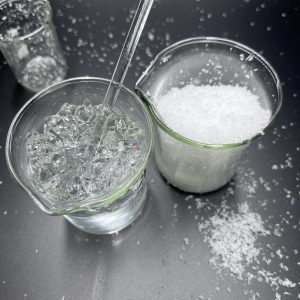I. Classification of Super Absorbent Polymers
Super absorbent polymers (SAPs) can be classified according to their chemical composition as follows:
- Polyacrylate-based SAPs: These are the most common types of SAPs, made from acrylic acid or its salts (such as sodium polyacrylate).
- Polyacrylamide-based SAPs: Made from acrylamide and used in agricultural and horticultural applications.
- Natural polymer-based SAPs: Derived from natural materials such as starch, cellulose, and chitosan, they are biodegradable and environmentally friendly.
- Hybrid SAPs: A combination of synthetic and natural polymers designed to combine the best properties of both types.

II. Development of Industrial Applications of Polyacrylate-Based SAPs
The development of industrial applications of polyacrylate-based SAPs covers several stages, from initial research and development to widespread commercial applications. The following is a brief overview of its development history:
- Research and Development Stage (1950s to 1960s)
- Late 1950s: Chemists began to study polymers with high water absorption capacity.
- 1960s: Researchers at the United States Department of Agriculture (USDA) discovered a polyacrylate-based polymer that can absorb large amounts of water. This discovery laid the foundation for the subsequent development of SAPs .
- Early Commercialization (1970s to 1980s)
- 1970s: The first generation of polyacrylate-based SAPs began to be used in agriculture and horticulture as soil moisturizers .
- 1980s: Polyacrylate-based SAPs were widely used in hygiene products (such as diapers and sanitary napkins). Due to their excellent water absorption properties, these products quickly occupied the market and promoted further research and development of SAPs .
- Widespread Application and Technological Improvement (1990s to 2000s)
- 1990s: The production technology of polyacrylate-based SAPs was significantly improved, and the product quality and performance were greatly enhanced. The application of SAPs in the hygiene products market was further expanded, gradually replacing traditional absorbent materials .
- 2000s: The research focus shifted to improving the water absorption rate, water absorption capacity, and biodegradability of SAPs. At the same time, the application of SAPs in medicine, food packaging, and construction began to be explored .
- Continuous Innovation and Diversified Applications (2010s to Present)
- 2010s: Due to the improvement of environmental protection requirements, the research and development focus gradually shifted to SAPs based on natural substrates and biodegradable polyacrylate-based SAPs. High-performance SAPs were also developed for use in medical, industrial, and special fields.
- 2020s: The application scope of polyacrylate-based SAPs has been further expanded, especially in the fields of smart agriculture, drug-controlled release, waste liquid treatment, and environmental remediation. The research and development of new SAPs focus on the sustainability and versatility of materials to meet the increasingly severe environmental and resource challenges.
Key Development Trends
Environmental Friendliness and Biodegradability: As environmental awareness grows, there has been a significant shift in research and development towards biodegradable and eco-friendly SAPs. Traditional polyacrylate-based SAPs, while highly effective, are often not biodegradable and can contribute to long-term environmental pollution. In response, scientists are exploring natural materials, such as cellulose and starch, as bases for creating SAPs that break down more easily in the environment. Additionally, efforts are being made to modify existing synthetic polymers to enhance their biodegradability without compromising their performance.
High Performance and Multifunctionality: The focus on improving the water absorption capacity of SAPs continues, aiming to create products that can absorb and retain even larger amounts of liquid more quickly. Beyond just water absorption, new functionalities are being integrated into SAPs to make them more versatile. For instance, SAPs are being developed to act as controlled-release agents for fertilizers in agriculture, ensuring that nutrients are gradually released into the soil to optimize plant growth. In the pharmaceutical industry, SAPs are being designed to deliver drugs at a controlled rate, enhancing the efficacy and safety of treatments.
Smart Applications: With advancements in the Internet of Things (IoT) and smart control technologies, SAPs are being tailored for use in smart agriculture and intelligent packaging. In smart agriculture, SAPs can help regulate soil moisture levels and monitor plant health, providing real-time data to farmers for better crop management. These SAPs can also be integrated with sensors and wireless communication systems to create a responsive and adaptive agricultural environment. In intelligent packaging, SAPs are being used to maintain optimal humidity levels, extend the shelf life of products, and even provide indicators for freshness. These innovations are paving the way for more efficient and sustainable practices in various industries.
Commitment to Innovation and Environment
At GELSAP, our commitment to innovation is matched by our dedication to environmental stewardship. By focusing on bio-based product development, we are not only addressing the immediate needs of various industries but also contributing to long-term ecological balance. Our goal is to provide high-performance materials that meet the demands of modern applications while ensuring a positive impact on the environment.
Future Prospects
As we continue to expand our bio-based product line, we remain focused on enhancing the sustainability and performance of our polymers. Our research and development efforts are driven by a vision of a future where industrial growth and environmental responsibility go hand in hand.
By leveraging our expertise in polymer science and our commitment to sustainable development, GELSAP is leading the way towards a more sustainable and environmentally friendly future. We invite you to join us on this journey and explore the benefits of our innovative bio-based products.
References
- USDA. (1960s). Development of polyacrylate-based polymers for water absorption. United States Department of Agriculture.
- USDA. (1970s). Early applications of polyacrylate-based SAPs in agriculture and horticulture. United States Department of Agriculture.
- USDA. (1980s). Widespread use of polyacrylate-based SAPs in sanitary products. United States Department of Agriculture.
- USDA. (1990s). Advancements in production technologies for polyacrylate-based SAPs. United States Department of Agriculture.
- USDA. (2000s). Research and applications of SAPs in various fields. United States Department of Agriculture.

